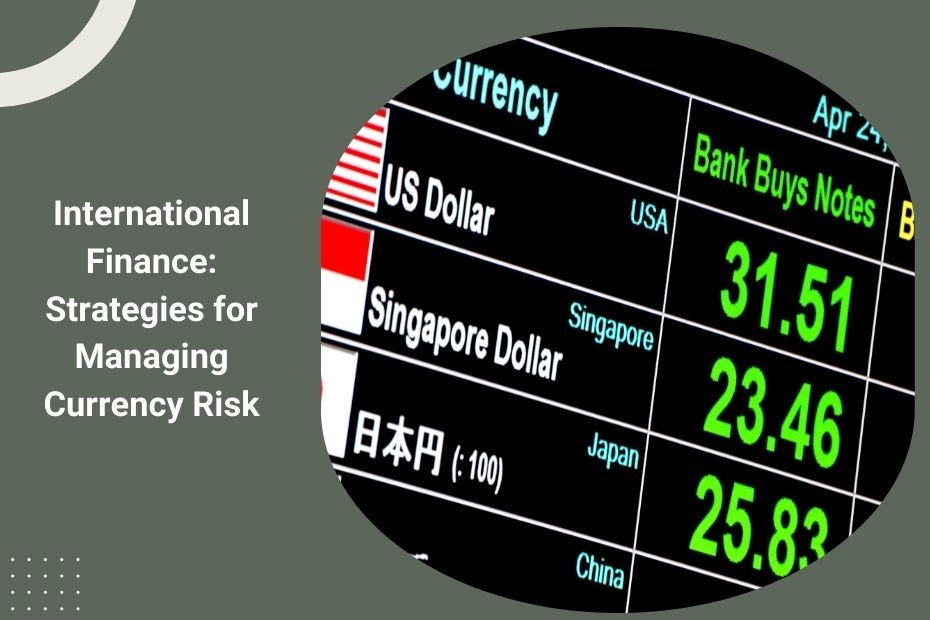Currency risk is something you need to plan for—not react to—if you’re doing business across borders, managing international investments, or dealing with foreign suppliers or clients. Exchange rate fluctuations can disrupt your forecasts, squeeze your margins, and even flip a profitable deal into a loss. You can’t control how currencies move, but you can control how exposed you are and how well prepared you are to respond. This article walks you through practical, actionable strategies for managing currency risk in international finance, so you can stay competitive and financially secure—no matter which direction the markets turn.
Why Currency Risk Matters to You
Currency risk—or foreign exchange risk—isn’t limited to forex traders. If your revenue, expenses, assets, or liabilities are tied to foreign currencies, your exposure is real. A shift in the exchange rate between the time you sign a deal and the time you settle the invoice can mean you’re suddenly paying more or earning less than expected.
This applies across the board—whether you’re invoicing customers in euros while your base is in dollars, or holding bonds issued in yen. The global market reacts to inflation data, geopolitical news, interest rate changes, and central bank policies. Even minor shifts in those factors can lead to real financial consequences for your bottom line.
Forward Contracts: Bringing Predictability to Cash Flow
One of the most widely used tools in currency risk management is the forward contract. A forward allows you to fix an exchange rate for a future transaction. This is especially helpful when you know the amount and timing of your foreign currency exposure.
For example, if you’re scheduled to pay a supplier in six months in euros, a forward contract lets you lock in the exchange rate today—regardless of what happens in the currency market later. This approach removes uncertainty and supports accurate financial planning, particularly when working with large or recurring international transactions.
Currency Options: Flexibility with a Safety Net
While forward contracts lock you into a rate, currency options give you the right—but not the obligation—to exchange currencies at a predetermined rate by a set date. Options protect you against unfavorable movements while allowing you to benefit from favorable ones.
Consider using a currency option when there’s a chance the market could move in your favor, but you want to hedge against a worst-case scenario. You’ll pay a premium for the protection, but in volatile conditions, this cost can be worth the flexibility.
Natural Hedging: Balancing Operations to Offset Risk
Natural hedging refers to structuring your operations to balance foreign currency inflows and outflows. If you generate revenue in a specific currency, it makes sense to also incur expenses in that same currency. This way, you reduce the need for conversions and lower your exposure to exchange rate fluctuations.
A company selling goods in the UK, for example, can look to source raw materials or labor locally in British pounds. Opening local currency accounts is another useful step—enabling you to hold funds without exchanging them unnecessarily and exposing yourself to currency risk.
Currency Swaps: Exchanging Flows for Strategic Gains
Currency swaps are contractual agreements between two parties to exchange principal and interest payments in different currencies. These are often used to secure funding at better rates or to hedge long-term currency exposures.
If you need to borrow funds in a foreign currency but can secure better terms in your home market, a currency swap lets you access the funds you need while managing the risk of rate fluctuations. These agreements are especially useful in long-term financing or when working across regions with significant currency volatility.
Diversifying Currency Exposure to Spread Risk
Diversifying your exposure across multiple currencies reduces the impact that any single currency movement can have on your financial outcomes. This applies whether you’re managing investments, running a multinational operation, or holding assets abroad.
If your business revenue is concentrated in a single foreign currency, consider expanding into markets that use different currencies. If you’re an investor, building a portfolio with exposure to multiple regions can buffer the effect of one currency losing value. Diversification won’t eliminate risk, but it lowers the chance that one currency swing derails your broader financial plan.
Currency ETFs: A Simple Way to Gain Exposure
Currency exchange-traded funds (ETFs) offer a convenient way to hedge exposure or make strategic decisions related to currency movements. These funds track the performance of a single currency or a basket of currencies and are available through most major brokerage platforms.
Currency ETFs can be used to protect the value of foreign income or assets, without the need to enter into direct forex contracts. They are especially useful for investors who want a more passive tool to manage currency risk alongside other assets in their portfolio.
Stop-Loss Orders: Enforcing Discipline in Volatile Markets
Stop-loss orders are a straightforward and effective way to control potential losses when dealing with currency positions. You set a trigger point, and once the currency hits that level, your position is automatically closed. This approach is common in trading, but it’s also helpful for financial professionals managing ongoing exposure.
Stop-loss orders allow you to automate your response to sudden market moves and enforce discipline—avoiding emotional decisions in fast-changing markets. This tool works best when paired with a well-defined risk management strategy and accurate data on currency trends.
Top Tools for Managing Currency Risk Effectively
- Forward contracts lock in future exchange rates.
- Currency options offer protection with upside flexibility.
- Natural hedging aligns your revenues and expenses.
- Currency swaps help secure better loan terms and hedge exposure.
- Diversification reduces reliance on a single currency.
In Conclusion
If you’re dealing with international transactions, currency risk is part of the game—but it doesn’t have to be a gamble. You have tools at your disposal to bring predictability, flexibility, and control to your financial strategy. Whether you’re locking in rates with forwards, adding insurance with options, or building in protection through natural hedges and diversification, the key is to be proactive. The right mix of strategies depends on your business model, risk tolerance, and operational needs. But once you put a solid plan in place, you’ll be able to manage currency exposure with confidence—and focus on growth, not volatility.
For more insights on global finance, risk strategies, and practical tools to navigate international markets, explore my YouTube profile where I dive deeper into topics like currency risk management and financial strategy.

Thomas J. Powell is a distinguished Senior Advisor at Brehon Strategies and a recognized figure in the realm of entrepreneurship and private equity. His journey in the financial services and banking sector, starting in 1988 in Silicon Valley, spans more than 35 years and is marked by profound industry expertise. Powell’s dual citizenship in the European Union and the United States empowers him to adeptly steer through international business landscapes. Currently studying for his Doctor of Law and Policy at Northeastern University, his research is centered on addressing the shortage of middle-income workforce housing in rural resort areas. Alongside his professional pursuits, he remains committed to community enrichment, illustrated by his 45-year association with the Boys and Girls Clubs of America. Follow Thomas J Powell on Twitter, Linkedin etc.

